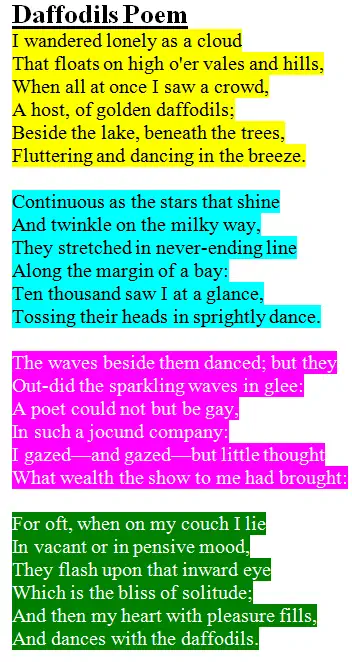
Introduction of William Wordsworth
William Wordsworth is considered the poet of nature. He was one of the romantic poets. Most of his poetry is about the human relationship with nature. Wordsworth saw the daffodils while roaming the countryside. He was inspired by the daffodils and wrote a poem on them because he loved nature. He felt nature like a living thing.
Summary of the Daffodils Poem
In this poem, the poet elaborates the real beauty of nature. He presented him as a cloud that wanders alone. He shares his experience of enjoyment when he saw a field of daffodils beside the bank of a lake. When he was wandering in the countryside. Here, the poet used a figure of speech ‘simile’ when he says that “I wandered lonely as a cloud”.
He compared himself with a cloud that roams here and there. The flowers were in full bloom and were moving because the breeze was blowing. In this poem, Wordsworth used another term ‘personification’ in which non-living things are attributed as living things. Daffodils that the poet saw were moving because of the wind whereas the poet mentioned them as they were “Fluttering and dancing”.
The poet says that the daffodils were looking like stars that were shining and twinkling. They were a lot in numbers that he saw at one glimpse. Again he used personification and says that they were “Tossing their heads in sprightly dance”
The poet recalls that sight and says that the waves of water within the lake were also sparkling and dancing with pleasure. But they didn’t inspire the poet as much as the daffodils. The poet felt lighthearted by enjoying that cheerful company. He continued to look at that scene. He felt that he had gained a wealth of happiness from that sight.
That sight fascinated and delighted the poet and left an everlasting impression on him. Whenever he felt loneliness, restlessness, or bored, he used to memorize those beautiful daffodils. That scene came into his imagination and became a source of joy and pleasure. He feels that his heart becomes delightful “And dances with the daffodils”
In this poem, the poet used figurative language and presented nature such as fields, clouds, hills, breeze, lakes, daffodils, stars, and trees in an artistic manner.
Daffodils Poem Questions Answers
QUESTION 1: Why do we call Wordsworth a poet of nature?
ANSWER: Wordsworth loved nature the most. He even gave human attributes to nature. Most of his poems are about the relationship between nature and human beings. That’s why we call him a poet of nature.
QUESTION 2: Where did the poet see the daffodils?
ANSWER: The poet saw the daffodils growing by the lake, beneath the trees.
QUESTION 3: How many daffodils did Wordsworth see at a glance?
ANSWER: Wordsworth saw ten thousand daffodils at a glance. Actually, he said it to emphasize that the entire area was covered with uncountable daffodils.
QUESTION 4: Why did the poet compare the waves with the daffodils?
ANSWER: According to the poet, the daffodils were tossing their heads. The waves were also moving and dancing. The poet felt the movement of the daffodils was more impressive than the waves. So, he compared the two.
QUESTION 5: What do the daffodils represent?
ANSWER: The daffodils represent beautiful nature and its everlasting effects on human beings.
QUESTION 6: What do we learn in the last stanza?
ANSWER: In the last stanza, the poet tells that whenever he is alone and sad, he recalls the scene of daffodils. He feels them dancing in his imagination so, his heart also begins to dance and he feels happiness and joy. So, the last stanza tells us that whenever we are uncomfortable or in despair, we should memorize the sweet moments we spent before so that we can cheer up and forget our sorrows.
Topic Covered:
9th class, 10th class, first year, second year,Glossary, Comprehension, Vocabulary (B & C), Grammar
(C, D, E, F & G), Writing Skills (B).